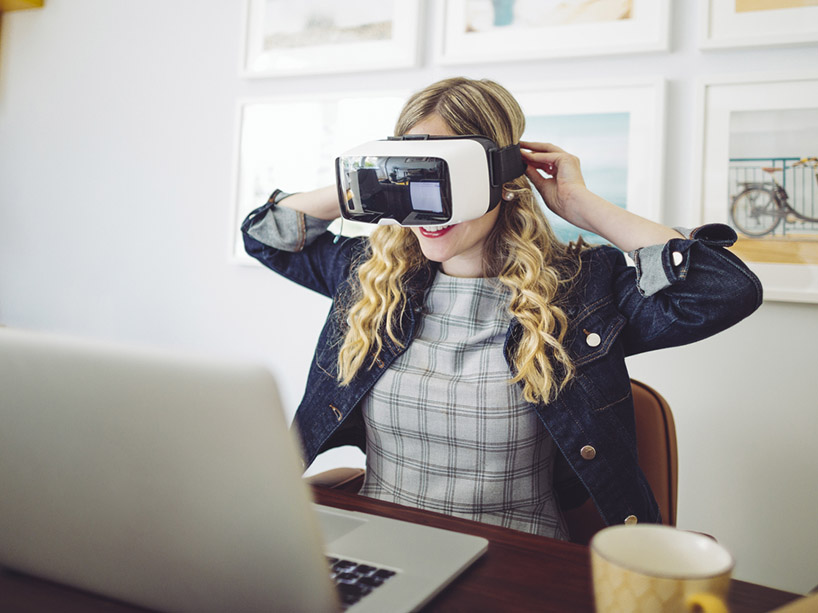How VR is helping students explore youth care and counselling

An online relational practice course for master’s students in Child and Youth Care uses immersive virtual reality to explore trauma-informed practices, self-care, and crisis intervention
Professor Jennifer Martin has long been exploring the intersection of new digital technologies, child sexual abuse and exploitation, and clinical practice. In 2016, she developed an innovative graduate course called Online Relational Child and Youth Care Practice that used simulations to explore digital technologies in human services and foster cyber-counselling competencies and therapeutic relationship-building skills in the online environment.
“At that time, students and practitioners were discouraged or often prevented from working with young people online due to ethical and liability issues,” said Martin. “Then, COVID-19 happened. Everyone was forced to move online.”
Martin noted that the shift to online life resulted in a global increase in technology-assisted sexual abuse and child sex trafficking, and that lockdown in general was negatively affecting the mental health of young people. She wanted to focus on these important issues. How can practitioners engage online with young people in a way that makes them feel safe, especially after many have already experienced harm online?
“It’s a place of both perils and possibilities,” said Shannon Brown, a research assistant in Child and Youth Care who assists Martin with the course.
How the course works
The online relational practice course has evolved since 2016 by incorporating immersive virtual reality (VR) technology and a trauma-informed perspective. Each student is provided with an Oculus Quest VR headset for use during the course, funded by a Learning & Teaching Grant through the Centre for Excellence in Learning & Teaching.
Students are fully immersed in a dynamic, adaptive, interactive virtual environment. Martin noted that this immersive experience surrounds students with continuous sensory input.
“Students can engage in therapeutic encounters in ways that would be impossible in a typical classroom-based simulation,” she said. “VR enables students to interact with the environment and virtual characters in a way that feels real, helping them engage in self-directed exploration, fostering autonomy during decision-making.”
Replicating real-world interactions
Experiential learning in VR can include immersive guided mindfulness meditation or simulations such as an emergency room practitioner working with a young person who has overdosed, or a practitioner responding to a young person who is suicidal and threatening to jump from a bridge.
These scenarios are designed to replicate real-world interactions and encourage decision-making, critical thinking and clinical reasoning skills. They are also repeatable, allowing learners to make mistakes safely while learning and improving through intentional practice.
Research has demonstrated the effectiveness of VR and the immersive experiential learning it enables. Advances in technology continue to improve hand control (for complex tasks), voice control (for communication skills), and haptics (the sense of touch in VR), further blurring the lines between the real and the virtual.
What students have to say
Steven Gibson and Florence Krystyne Chantler are completing their master’s degrees in the Child and Youth Care program and are enrolled in the course.
“This online relational course is the epitome of where our practices are going,” said Chantler, a long-time practitioner who is taking the course to upgrade her skills and remain current. “The thought of doing some therapeutic work online was initially a little unimaginable.”
Both students are aware that understanding technology is an important part of their profession, and find the VR environment particularly helpful.
“It is a good exercise for how to offer good practice to young people,” said Gibson. “It’s interesting to step into something this active. It feels like it’s moving forward. It informs what we’re going to do in the future.”
The VR experiences have helped them reflect on their practice, too. For example, Chantler has been able to experience virtual reality Chat Rooms and other immersive experiences that young people engage in, using a trauma lens to consider online harms.
“Virtual reality has lots of potential,” said Gibson. “It’s here to stay and we need to engage with it.”
As for the future of VR in therapeutic practices, everyone acknowledges that while it is the way of the future, there is learning left to do. Martin says the course will continue to evolve with emerging technologies and will be offered again next year.
